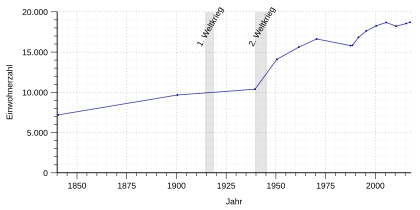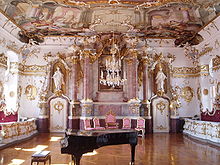Dillingen on the Danube
| coat of arms | Germany map | |
|---|---|---|
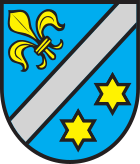
|
Coordinates: 48 ° 35 ' N , 10 ° 30' E |
|
| Basic data | ||
| State : | Bavaria | |
| Administrative region : | Swabia | |
| County : | Dillingen on the Danube | |
| Height : | 433 m above sea level NHN | |
| Area : | 75.58 km 2 | |
| Residents: | 19,149 (Dec. 31, 2019) | |
| Population density : | 253 inhabitants per km 2 | |
| Postal code : | 89407 | |
| Primaries : | 09071, 09074 | |
| License plate : | DLG, WHO | |
| Community key : | 09 7 73 125 | |
| LOCODE : | DE DLD | |
| City structure: | 12 parts of the community | |
City administration address : |
Königstrasse 37/38 89407 Dillingen an der Donau |
|
| Website : | ||
| Lord Mayor : | Frank Kunz (CSU) | |
| Location of the city of Dillingen an der Donau in the district of Dillingen an der Donau | ||
Dillingen an der Donau (officially: Dillingen ad Donau ) is a large district town and the administrative seat of the district of the same name in the Bavarian administrative district of Swabia . Together with Lauingen it forms a dual regional center .
geography
Geographical location
Dillingen is located in Northern Swabia , on the north bank of the Danube in the Donauried . The border with Baden-Württemberg runs about 15 km from Dillingen. Augsburg as the closest regional center is around 50 km away.
Expansion of the municipal area
There are 12 officially named municipal parts (the type of settlement is given in brackets ):
|
|
climate
| Dillingen / Danube-Fristingen (416 m) | ||||||||||||||||||||||||||||||||||||||||||||||||
|---|---|---|---|---|---|---|---|---|---|---|---|---|---|---|---|---|---|---|---|---|---|---|---|---|---|---|---|---|---|---|---|---|---|---|---|---|---|---|---|---|---|---|---|---|---|---|---|---|
| Climate diagram | ||||||||||||||||||||||||||||||||||||||||||||||||
| ||||||||||||||||||||||||||||||||||||||||||||||||
|
Monthly average temperatures and precipitation for Dillingen / Donau-Fristingen (416 m)
Source: www.wetterdienst.de
|
||||||||||||||||||||||||||||||||||||||||||||||||||||||||||||||||||||||||||||||||||||||||||||||||||||||||||||||||||||||||
history
Early history
The linear ceramic grave field in Dillingen-Steinheim is one of the best-researched of the Stone Age in Central Europe. The origins of the city of Dillingen can be traced back to an Alemannic settlement.
Middle Ages and Early Modern Times

Coming from Wittislingen , the later Counts of Dillingen settled in the Danube Valley in the 10th century, with their castle becoming the center of today's district town of Dillingen. Mentioned for the first time in 973, Dillingen fell in 1258 as a gift to the Augsburg bishopric , which belonged to the Swabian Empire from 1500 onwards. It was the seat of the bishops of Augsburg from the 15th century until the secularization in 1803. The prince-bishops of Augsburg, especially the two cardinals among them, promoted the growth of the city as city lords.
Cardinal Peter von Schaumberg converted the Dillingen Castle into a late Gothic castle and established the government of the bishopric in it. Cardinal Otto Truchseß von Waldburg founded the University of Dillingen in 1549/1551 and brought Sebald Mayer to the new university town as the first book printer (Sebald Mayer's son Johann then took over this academic printing company from 1576). The university with a theological focus was handed over to the Jesuits in 1563 and became the first fully developed Jesuit university on the soil of the Holy Roman Empire of the German Nation to gain national importance.
Witch hunts
During the witch hunts from 1574 to 1745 65 people were indicted in Dillingen, most of whom did not survive the witch trial . In 1587, Walpurga housewife was burned alive at the stake . The last victim of the witch trials in 1745 was Barbara Zielhauser. A memorial plaque from the Rotary Club, which was unveiled on December 12, 1994 in the courtyard of the Dillingen Palace, against the resistance of the Episcopal Ordinariate, commemorates her fate.
Modern
In 1802 and 1803 the city became part of Bavaria. The university was converted into a lyceum for the training of Catholic theologians, from which in 1923 the " Philosophical-Theological University Dillingen " emerged. In 1862 the district office of Dillingen an der Donau was founded. On July 1, 1972, the district of Dillingen on the Danube was created in its current form, including the previously independent city of Dillingen, which became the major district town. In addition, the originally independent community of Hausen was incorporated on this day.
Incorporations
| Former parish |
Area ha |
Resident (May 27, 1970) |
Incorporation date |
|---|---|---|---|
| Dillingen | 1839.95 | 11,547 | |
| Donaualtheim | 717.21 | 911 | 05/01/1978 |
| Fristingen | 1297.76 | 700 | 05/01/1978 |
| Hausen | 469.36 | 540 | 07/01/1972 |
| Kickling | 1472.49 | 683 | 05/01/1978 |
| Schretzheim | 362.21 | 1,144 | 05/01/1978 |
| Steinheim | 1404.50 | 1.102 | 05/01/1978 |
| total | 7563.48 | 16,627 |
Population development
Dillingen on the Danube grew by 2,514 inhabitants or around 16% between 1988 and 2008. Between 1988 and 2018, the city grew from 15,827 to 18,978 by 3,151 inhabitants or 19.9%. The population figures from 1840 onwards relate to today's municipality area (status: 1978).
| Population development | |||||||||||||||
|---|---|---|---|---|---|---|---|---|---|---|---|---|---|---|---|
| year | 1840 | 1900 | 1939 | 1950 | 1961 | 1970 | 1987 | 1988 | |||||||
| Residents | 7,196 | 9,669 | 10,388 | 14,099 | 15,610 | 16,627 | 15,803 | 15,827 | |||||||
| year | 1991 | 1995 | 2000 | 2005 | 2010 | 2015 | 2017 | ||||||||
| Residents | 16,822 | 17,630 | 18,264 | 18,678 | 18,215 | 18,547 | 18,699 | ||||||||
politics
Lord Mayor
The Lord Mayor has been Frank Kunz (CSU) since May 2008. Kunz, born in 1972, was re-elected in March 2014 with 96.6% of the vote and confirmed in office on March 15, 2020 with 84.8% for a further six years. His predecessor was Hans-Jürgen Weigl.
City council
The city council has 24 members. The local elections on March 15, 2020 resulted in the following distribution of seats in the city council:
| Party / group | Seats | +/- |
|---|---|---|
| CSU | 8th | ± 0 |
| SPD | 1 | - 1 |
| Green | 2 | + 1 |
| AfD | 1 | + 1 |
| Young Union (JU) | 1 | + 1 |
| Free voters (FW) | 2 | ± 0 |
| Schretzheim list | 2 | ± 0 |
| Steinheim voter community | 2 | ± 0 |
| Kicklingen voters' association | 1 | - 1 |
| Voters in Fristingen | 1 | - 1 |
| Bürgergemeinschaft Hausen | 2 | ± 0 |
| General list of voters Donaualtheim | 1 | ± 0 |
Sister cities and sponsorships
- Town twinning
- Sponsorships
- In 1988 the sponsorship for the expelled Germans from the city of Hostau in the Bohemian Forest was taken over.
- In 1998 a sponsorship with the submarine training center of the German Navy in Eckernförde was signed.
Political symbols
The city carries a flag and a coat of arms.
coat of arms
| Blazon : "In blue a silver oblique left bar, above an oblique golden lily, below two six-pointed golden stars" | |
banner
Yellow-white-blue
Culture and sights
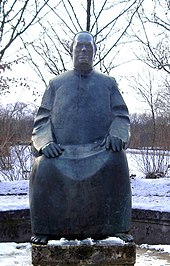
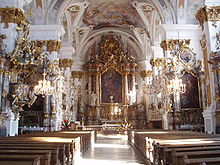
Culture
The most famous person who worked in Dillingen was Sebastian Kneipp . Kneipp was accepted into the local grammar school in 1844 and began studying theology in the city on the Danube in 1848 . Today a Kneipp circuit through the city reminds of the work of the priest and hydrotherapist in Dillingen. In the City and Hochstift Museum there is also an exhibition on Kneipp's healing success and the development of his Kneipp medicine .
In 2007 the Dillinger Basilica Concerts were launched. Since then, three concert cycles with various events have taken place in St. Peter's Basilica every year.
The Dillinger Kulturtage also takes place every two years in autumn.
Attractions
- St. Peter's Basilica , three-aisled hall church with construction started in 1619, built on the foundations of previous churches , which date from the 13th and 15th centuries. In 1979 the church was elevated to a papal minor basilica .
- Academy for teacher training and personnel management in the former university of the Jesuit college with the Golden Hall and the historic library hall.
- Study Church of the Assumption , Renaissance building with Rococo furnishings. The church was part of the former university and was a place of consecration for the priests of the Augsburg diocese .
- Monastery church of the Assumption of the Dillinger Franciscan Sisters , gem of the early Rococo , Wessobrunn stucco .
- Castle , former seat of the Augsburg prince-bishops , oldest parts from the Staufer period, ensemble of different architectural styles, extensively restored.
- Heilig Geist Spitalkirche , late-Gothic building with Wessobrunn stucco in Baroque style at the end of the 17th century.
- Königstraße, central street with Mitteltorturm, town hall (roof truss fire on July 26, 2017) and a well-preserved historical street scene, u. a. City and Hochstift museum , as well as the upper pharmacy.
- neo-Romanesque parish church "Maria Rosenkranzkönigin" in the Schretzheim district.
Economy and Infrastructure
Companies
The settlement of trade and industry took place mainly after the Second World War.
Well-known resident companies are for example:
- BSH Hausgeräte Dillingen
- Deutz-Fahr Lauingen
- Röhm GmbH , clamping tool manufacturer in Sontheim
- Organ building Sandtner
- Wetzel (manufacturer of Karlovy Vary wafers, waffles and chocolate specialties)
traffic
The Regensburg - Neuoffingen (- Ulm ) route, also known as the Danube Valley Railway , runs through the city . The regional railways between Donauwörth and Günzburg cross in Dillingen. Until 1972, this was also the southern terminus of the Härtsfeldbahn , a narrow-gauge railway (1000 mm) that connected Dillingen with Aalen .
Local public transport is offered by two city bus routes that serve the core city and the districts of Hausen, Donaualtheim and Schretzheim.
Dillingen can be reached by car via Bundesstraße 16 . The nearest motorway connections are in Giengen an der Brenz ( A 7 ) and Günzburg ( A 8 ) and are around 25 km away. The nearest airports are Augsburg (around 50 km) and Munich and Stuttgart airports (around 130 km each)
In addition, the Danube Cycle Path leads through the city.
Healthcare
With the St. Elisabeth District Hospital, the city has an efficient hospital at its disposal. The operator is the Kreiskliniken Dillingen-Wertingen gGmbH .
With the Regens-Wagner-Foundation there is also an institution for the care and support of people with multiple disabilities and hearing impairments. There is also an ecumenical social station and the Heilig-Geist-Stift, a senior citizens' and nursing home.
education
- Josef-Anton-Laucher primary school
- Angelina Egger primary school
- Josef Anton Schneller Middle School
- Johann-Michael-Sailer-Gymnasium
- St. Bonaventura Technical College (founded in 2018)
- St. Bonaventure Secondary School
- St. Bonaventure High School
- Theresia-Haslmayr-Schule, private special education support center
- IHK Academy Swabia
- Adult Education Center Dillingen
- Academy for teacher training and personnel management
- FD Bildungsakademie (Academy for Languages)
- Professional training centers of the Bavarian economy (bfz) gGmbH
- Specialized Academy for Social Pedagogy Dillingen of the Schulwerk of the Diocese of Augsburg
- Princely and Countess Fugger Family and Foundation Archives
Public facilities
- Six kindergartens in the city area
- Study library (including holdings from the former prince-bishop's library)
- City library
- District Court
military
The Luitpold barracks on the eastern outskirts of the city houses the information technology battalion 292 (formerly command support battalion 292 , formerly telecommunications battalion 230), until the end of 2008 parts of the airborne telecommunications company 200 and parts of the Bundeswehr service center in Ellwangen.
Sports
Not far from the Danube is the Danube Stadium, which was completely renovated in 2007.
Personalities
literature
- Wolfgang Wüst : Hochstift Augsburg, City of Dillingen and University: topographical, legal, economic and social interrelations. In: Rolf Kießling (ed.): The University of Dillingen and its successors. Stations and aspects of a university in Swabia. Festschrift for the 450th anniversary of the founding (Yearbook of the Historical Association Dillingen an der Donau, 101). Dillingen / Donau 1999, ISBN 3-00-005143-0 , pp. 407-448.
- Wolfgang Wüst: Spiritual state and old empire: Early modern forms of rule, administration and court keeping in the Augsburg prince bishopric (studies on the Bavarian constitutional and social history, XIX / 1 and XIX / 2). Munich 2001, ISBN 3-7696-9709-X , on Dillingen in particular pp. 511-528.
- District of Dillingen ad Donau - very personal. Idea and conception: Rainer Wendorff. NeomediaVerlag, Coesfeld 2018, ISBN 978-3-931334-80-2 .
- Franz Dionys Reithofer : Chronological history of the Bavarian cities of Dillingen, Lauingen and Rain ; collects materials on the history of the former University of Dillingen , and notes from strange Lauingen residents from unused handwritten sources . Dillingen 1821 ( e-copy ).
Web links
- City administration
- Literature from and about Dillingen an der Donau in the catalog of the German National Library
- Dillingen an der Donau: Official statistics of the LfStat
Individual evidence
- ↑ "Data 2" sheet, Statistical Report A1200C 202041 Population of the municipalities, districts and administrative districts 1st quarter 2020 (population based on the 2011 census) ( help ).
- ^ City Council> Members. City administration Dillingen, accessed on June 7, 2020 .
- ^ Community Dillingen an der Donau in the local database of the Bavarian State Library Online . Bayerische Staatsbibliothek, accessed on August 31, 2019.
- ↑ Otto Bucher: Bibliography of the printed works of the Dillinger book printer Ignaz Mayer (1654–1668). In: Börsenblatt for the German book trade - Frankfurt edition. No. 89, November 5, 1968 (= Archive for the History of Books. Volume 62), pp. 2888–2912, here: p. 2888.
- ↑ Names of the victims of the witch trials / witch persecution Dillingen (PDF; 84 kB; accessed on April 27, 2016)
- ↑ Harald Siebenmorgen : Witches and witch persecution in the German southwest. Cantz Verlag, Ostfildern 1994, Volume II, p. 309ff.
- ↑ Wolfgang Behringer : Witch hunt in Bavaria: Folk magic, religious zeal, and reasons of state in the early modern period. Study edition, R. Oldenbourg Verlag GmbH, Munich 1988.
- ↑ Memorial plaque in the Dillinger castle courtyard for the victims of the witch trials
- ↑ a b Wilhelm Volkert (Ed.): Handbook of the Bavarian offices, communities and courts 1799–1980 . CH Beck, Munich 1983, ISBN 3-406-09669-7 , p. 601 .
- ^ Official register of places for Bavaria, territorial status on October 1st, 1964 with statistical information from the 1961 census, Munich, 1964 , column 923.
- ↑ a b c d e Federal Statistical Office (Hrsg.): Historical municipality register for the Federal Republic of Germany. Name, border and key number changes in municipalities, counties and administrative districts from May 27, 1970 to December 31, 1982 . W. Kohlhammer, Stuttgart / Mainz 1983, ISBN 3-17-003263-1 , p. 770 .
- ↑ http://www.wahlen.bayern.de/kommunalwahlen/
- ↑ http://www.augsburger-allgemeine.de/dillingen/Kunz-Ich-weiss-dass-es-grosse-Schuhe-sind-und-hoffe-dass-ich-reinwachse-id3665106.html
- ↑ Large district town of Dillingen adDonau: Announcement of the final result of the election of the city council on March 15, 2020 , accessed on April 15, 2020
- ^ Entry on the coat of arms of Dillingen an der Donau in the database of the House of Bavarian History
- ^ Entry on the coat of arms of Dillingen an der Donau in the database of the House of Bavarian History
- ↑ http://www.kommunalflaggen.de/cgi-bin/db.pl?eintrag:09773125 :






